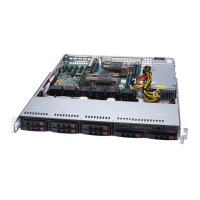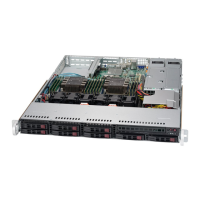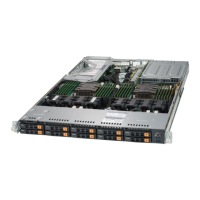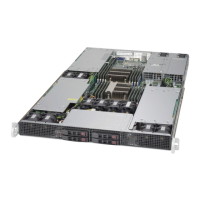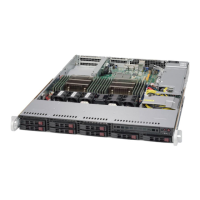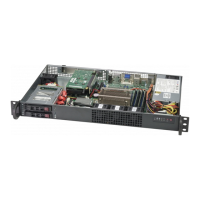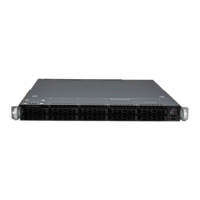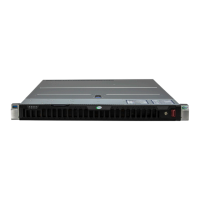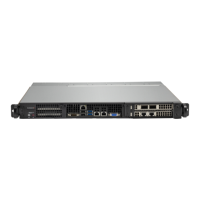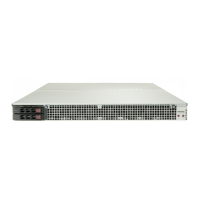
Do you have a question about the Supermicro SuperServer 1029GQ-TRT and is the answer not in the manual?
| Chipset | Intel C621 |
|---|---|
| Memory Slots | 16 DIMM slots |
| Power Supply Efficiency | 80 PLUS Platinum |
| Management | IPMI 2.0 with KVM and Dedicated LAN |
| Form Factor | 1U |
| Processor Support | Dual Intel Xeon Scalable Processors |
| Maximum Memory | Up to 2TB |
| Storage | 10x 2.5" hot-swap drive bays |
| Storage Controller | SATA3, SAS3 support with optional controllers |
| Expansion Slots | 2x PCI-E 3.0 x16, 1x PCI-E 3.0 x8 |
| Network Interface | Dual 10GBase-T LAN |
| Power Supply | Redundant Power Supply |
| Power Supply Wattage | 800W |
Provides a brief outline of the functions and features of the SuperServer 1029GQ-T(N/X/V)RT.
Instructions for inspecting the system box and handling potential shipping damage.
An overview of the main features of the 1029GQ-T(N/X/V)RT server.
Details on the server chassis, including control panel, front, and rear features.
Details on GPU support and configurations for different server models.
Diagram and description of the X11DGQ motherboard layout.
Provides a quick reference for jumpers, connectors, and LEDs on the motherboard.
Illustrates the system block diagram, including the Intel PCH C621 Chipset.
Provides advice and instructions for mounting the system in a server rack.
Guidelines for choosing a setup location and essential precautions.
Considerations for ambient temperature, airflow, mechanical loading, and grounding.
Detailed steps for installing the server rack rails, including inner and outer rails.
Instructions for installing the chassis into a rack and removing it.
Procedure to ensure power is safely removed from the system before maintenance.
Instructions on how to remove the chassis top cover for internal access.
Covers installation of processors, heatsinks, memory, and motherboard battery.
Details on storage drives, GPUs, system cooling, and power supply.
Describes the main ATX power and GPU power connections.
Details on various headers like fan, TPM, SGPIO, and connectors like M.2.
Information on Ethernet, SATA, and USB ports on the I/O back panel.
Explains jumper functions like CMOS Clear, Manufacturing Mode, and Watch Dog.
Describes the status indicators for Ethernet ports, IPMI, BMC, power, and unit ID.
Guide for installing the Windows operating system, including driver loading.
Instructions on downloading and installing necessary system drivers and utilities.
Information about the SuperDoctor 5 software for system monitoring and management.
Details on the Intelligent Platform Management Interface (IPMI) for remote access.
Describes the AMI BIOS setup utility and navigation methods.
Explains the main BIOS screen for setting date, time, and viewing system information.
Details advanced BIOS settings related to boot features, CPU, chipset, and power.
Settings for configuring and managing SMBIOS and system event logs.
Configuration options for the Intelligent Platform Management Interface (IPMI).
Configuration for administrator passwords, user passwords, and secure boot.
Options for selecting boot mode, boot order, and managing boot entries.
Options for saving or discarding BIOS configuration changes and exiting setup.
Lists common audible beep codes and their corresponding error messages.
Information on additional checkpoint codes and their documentation.
Introduces industry standard warnings to alert users to potential hazards.
Explains the meaning of the general warning symbol and associated hazards.
Provides an overview of the Unified Extensible Firmware Interface (UEFI).
Steps for recovering the UEFI BIOS image from a recovery block.
Procedure to recover the main BIOS block using a USB-attached device.
Information on the Intel VROC hardware key and its options.
Steps to enable NVMe RAID through the UEFI BIOS settings.
Explains the LED indicators on the drive carrier for RAID status.
Information on hot-plugging and hot-unplugging NVMe SSDs under vSphere ESXi.
